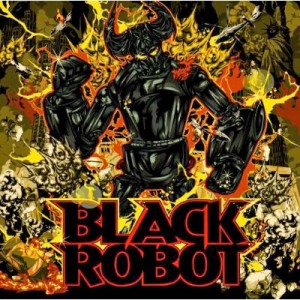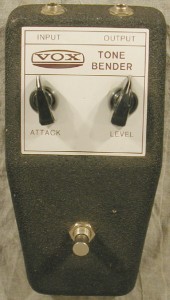Getting AC/DC Tones for Black Robot
 More Volume, Less Volume Knob…
More Volume, Less Volume Knob…
What is Black Robot? If you guessed a Japanese comic book, you’d be…wrong. It’s an LA-based band, a new one but made up of veteran players who wanted to make classic-sounding rock. And they did, thanks in large part to producer Dave Cobb.
Dave is a kung fu master of old-school tones, in part through his relentless use of old gear – amps and guitars yes, but also mic preamps and mixing boards. In this case, he also played most of the guitars on the album, so he’s a great guy to interview. Interesting dude, too. Here’s my interview with him:
WoodyTone: Sounds like old-school AC/DC tones on the album – was that what you were going for?
Dave Cobb: Yes, we love those AC/DC records. They all had very loud, clean, aggressive guitar sounds.
Why was that the sound you wanted for this record? Did you want an older-school feel?
My heroes growing up were Jimmy Page, Angus Young, Keith Richards, Pete Townshend – they all had a lot of aggression with their playing, but it was never super-distorted. A lot of kids crank up the distortion and think it’s heavy, but in actuality when it’s cleaner it has more weight and power to it. It makes you work for it.
I don’t really like modern-sounding records – I actually kind of hate them for the most part. So we weren’t really going after the [tone of the] old records, we were just going after what I like – which happens to be old records (laughs).
It seems like it’s a tough tone to get. A lot of people have tried, but in the modern era, even with all this fancy equipment, I just don’t hear it. Is it a tough tone to get?
Now we might have more stuff available, but it’s not as high-quality. [Back in the day] the guitars were American-made and made at the height of American craftsmanship, the Marshalls were made with quality parts, and you had quality players – you couldn’t record a record unless you had a high level of ability. Plus studios had the best mics in the world [and] they had good consoles and tape.” [He is trying to mimic that approach.]
What equipment did you use to get those tones and why?
I used a 1952 Les Paul Gold Top conversion with PAF pickups, a 1967 Marshall 50-watt and a Fender 1960 Tweed Deluxe, a Boss DM2 [analog delay], a vintage Vox Tone Bender and Colorsound Super Fuzz [Colorsound Tone Bender?], 10-gauge Ernie Ball strings and Fender medium picks.
Are they real PAFs?
The one in the bridge is a real PAF from the late ’50s, and the other one is a Gibson T-Top. I tried PAFs – tried a bunch – [in the neck] but nothing could beat the T-Top in that position.
What model of Marshall was it?
It was kind of a transitional year. I also used a 65 Amps amplifier a lot, the Nash Vegas. It’s a one-off they made, a really good amp. They’re one of the only amp companies that do it right.
Did you use the Marshall and Deluxe separately or did you combine them?
I can’t remember what we used on what now, but I like it Marshally.
How loud did you record?
The Marshall was more than halfway pushed. A lot of the secret in getting that tone is to push the amp hard and back the volume down on the guitar. When you hear the solos on AC/DC records, you hear the amp going into overdrive. [Angus] uses the [guitar] volume knob. That’s kind of a lost technique now.
What were the amps running through?
Some were running through a ’70s Marshall 2×12 that had 20-watt Celestions. We also had a Marshall 4×12, a checkerboard with black-back Celestion 25s in it.
For “Cocaine” we used a Jeff Bakos amp [Atlanta, Ga. tech and builder]. It’s real hi-fi, kind of like a JCM800 and a JTM 45 – it really has it going on. It’s called a Plus 45.
What do you like about those old pedals?
The Tone Bender can get an amp at the point of breakup. You throw the Tone Bender on all the way up, then back guitar volume all the way off, that’s how you get this chimey thing. It’s a really cool tone. I used that a lot. I used the Super Fuzz for some crazy effects.
Why did I think you had a Tele thing going on?
It was probably that Tone Bender trick.
What mics did you use?
I used Sennheiser 409s and used a room mic a lot.
You played all the guitars on the album?
I played about 80% of them. Yogi played some as well, and Andy [Andersson] too.
What track is your favorite?
“Cocaine.” I thought the solo on that was pretty hilarious. You can’t get away with making that kind of solo anymore. When I was a kid I read all those magazines and was trying to play like that. It’s been uncool for so long, it was so fun to let it all out. It was kind of, Let’s see how fast you can go, you know (laughs).
Did you learned any new tone secrets working on this record?
I think a lot of the record is kind of plug and play. The amps sound like they sound. There’s not a whole lot of work getting them to sound that way.
The drums – I love that sound. You can’t play a modern kit. You need an old Ludwig snare. Same with the amps. That stuff is still around – you just have to chase it. You can buy a mid-70s 50w Marshall and still get those sounds, whereas you can buy a $2,000 amp and it might not sound as good.
Notable
> Dave Cobb was the producer and co-writer on the self-titled debut album from Black Robot. Dave has worked artists including Shooter Jennings, Waylon Jennings, Chris Cornell, The Oak Ridge Boys, The Strays, Michael Johns,
Jamey Johnson and Nico Vega. Prior to becoming a producer, Dave was the guitarist for the ’90s band The Tender Idols.
> Who’s Yogi? Not a bear. He played guitar in Buckcherry along with Black Robot’s Jonathan “JB” Brightman (bass). Currently Yogi is the touring guitarist for Fuel.
> More on JB and Buckcherry (incidentally, he coined the name Buckcherry after pioneer 6-stringer Chuck Berry) from the Lubbock (TX) Avalanche-Journal: Brightman left Los Angeles-based sleaze-rockers Buckcherry in 2002, just as the band was closing in on mainstream success, for reasons, as Brightman describes them, straight out of Behind The Music. “I wanted to continue what I’d started, but unfortunately for me, when I played with Buckcherry, I just couldn’t tolerate what was going on with the interband politics,” he says. “It wasn’t good for me. In a nutshell, I didn’t have any place to live and was living out of a storage unit, living on a tour bus while a couple of guys were buying homes in the Hollywood hills. [Buckcherry] kind of took what was part of my legacy and kind of redefined what that was all about and I think started making lower-quality music.
“There were three of us that left the band and then they (the two founding members) went and formed a new version of Buckcherry and had this massive hit.” The first time he heard Buckcherry’s Billboard-charting, Paris-Hilton-sex-tape-inspired song? The one with an unprintable title? “I was like, ‘This is a piece of junk,'” he says. “It just sounded like some throwaway track we used to do, but people really locked in on it….”
The Making of Black Robot
> At 2:36 you can see and hear Dave playing the Les Paul. A very cool tone – I gotta try that Tone Bender trick!
Category: 65 Amps, AC/DC, Bakos amps, Boss/Roland, Colorsound, Fender, Humbuckers, Les Paul, Marshall, Vox pedals















Listened to the track a few times, now, and I like it more each time I hear it. Great tone, and a fresh take on the song (love that chimey Angus-like openeing riff). Also inspired me to try the turn up the amp, turn down the guitar and it DOES make for a meatier tone, even on my little Roland Cube. Can't wait to try it on the 100W Peavey when my wife's out of the house….